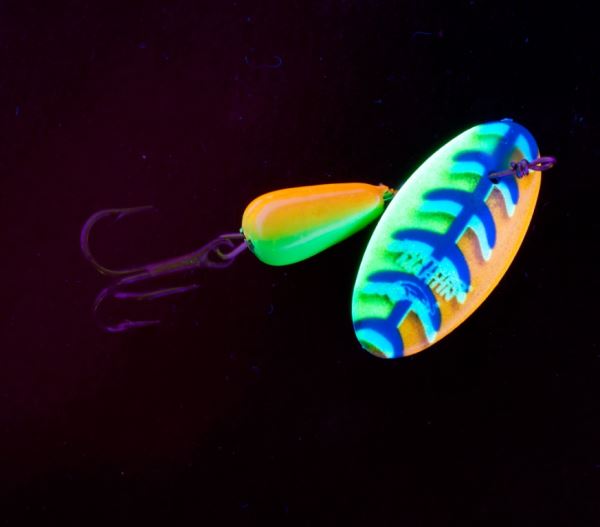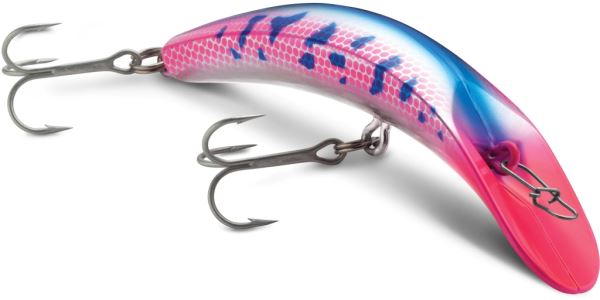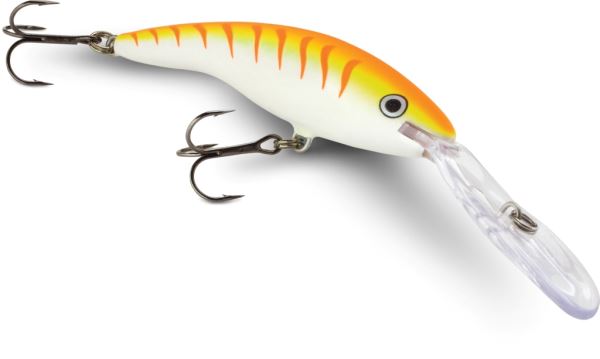
I spent countless cold winter hours as a Midwest kid poring through the tackle catalogs, daydreaming of fishing in distant waters and using the exotic baits shown within the dog-eared pages of my favorites from Herter’s, Garcia, Netcraft and others. A recurring fishing fantasy involved catching lake trout and salmon in famous far-north waters such as Great Slave Lake, Lake Nipigon and Lac Seul, spawned by the sight of the radical spoons and plugs for sale that flaunted garish day-glo colors that were said to be the key to attracting and catching the deep-dwelling salmonids and monster pike. I was well into adulthood before I was able to travel to some of those locales and test the effectiveness of the vibrantly colored attractors and lures, and experience for myself their effectiveness on salmon, trout and other North Country ‘exotics.’
Fast-forward to the present and you’ll find that florescent-colored lures, dyed natural baits, colorful dips and powders and even edible bedding that cause resident worms to assume unnatural colors are available today, all with the goal of making them more attractive—or at least more visible—to a wide variety of fish species we seek to fool and catch with the offerings.
Trending
 The latest fish-attracting craze assumes that fish not only can see florescent colors, which are actually reflected ultraviolet (UV) light, but its presence triggers them into action. Humans require ‘black lights’ to get the most out of UV colors; fish, on the other hand, may not. Recent studies by fisheries biologists show that some gamefish species can see the reflected UV light naturally, without the aid of additional lighting. What’s more, the skin of a fish—baitfish or gamefish—as well as some of their prey, from microscopic plankton to crustaceans, reflects UV light, according to some findings. That gives a fish that can see the light an advantage when pursuing or being pursued by same.
The latest fish-attracting craze assumes that fish not only can see florescent colors, which are actually reflected ultraviolet (UV) light, but its presence triggers them into action. Humans require ‘black lights’ to get the most out of UV colors; fish, on the other hand, may not. Recent studies by fisheries biologists show that some gamefish species can see the reflected UV light naturally, without the aid of additional lighting. What’s more, the skin of a fish—baitfish or gamefish—as well as some of their prey, from microscopic plankton to crustaceans, reflects UV light, according to some findings. That gives a fish that can see the light an advantage when pursuing or being pursued by same.
Another property of UV light that may offer a major advantage to anglers hoping to attract the attention of a fish is the light’s ability to penetrate deep and/or murky water. Fishing in low-light periods early and late in the day, lures with a UV finish or highlights may be more visible to fish than baits and lures without the optical enhancement.
All Natural
 Day-in and day-out, I remain in the more-natural-the-better school of lure selection. I think that baits that most closely resemble in size, shape and color the forage the gamefish I am seeking are feeding on, the better. “Matching the hatch,” to use a fly fishing term. That’s especially true when I am faced with clear water, bright light conditions when fish have a chance to inspect the fakes I offer and compare them to the real thing.
Day-in and day-out, I remain in the more-natural-the-better school of lure selection. I think that baits that most closely resemble in size, shape and color the forage the gamefish I am seeking are feeding on, the better. “Matching the hatch,” to use a fly fishing term. That’s especially true when I am faced with clear water, bright light conditions when fish have a chance to inspect the fakes I offer and compare them to the real thing.
That changes when I’m fishing waters that are less than clear and/or when light is dim. In low-light periods especially, I will appeal to my quarry’s other senses to attract their attention. I’ll use noisy top-waters with scooped faces and spinning blades to attract them by sound and vibration, and baits such as soft plastics infused with scent. And now that I know more about fish’s ability to see UV light, when faced with conditions when I feel the need to do something extra to get some attention, I think it’s only natural to start offering colorful crankbaits and neon nightcrawlers that may look anything but to our less UV-sensitive eyes.

